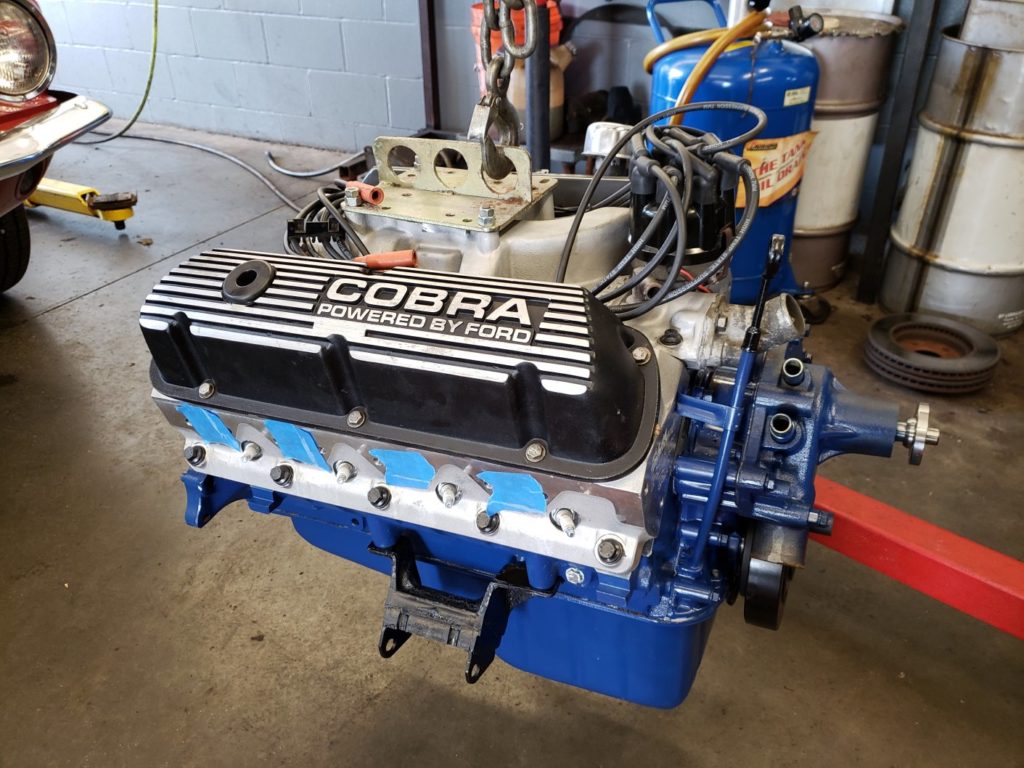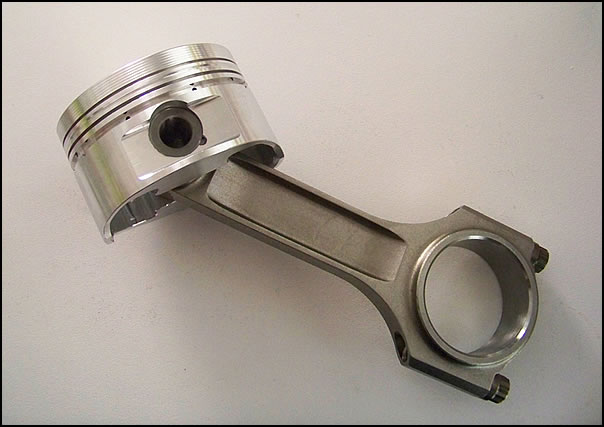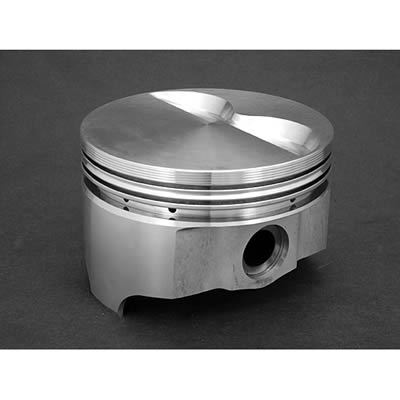Swapping out the old pistons for racing pistons
Return to the prior page My GT 350
All parts in an engine are important. And if you are building basically a racing engine for the street, the pistons you choose are a key element. So what happened to my engine was important to me. I wasn’t looking for just a nice rebuild. I wanted to do what fit my budget to make it better. I did a LOT of research on these engines. A lot of what I am putting on this set of web pages is what I learned.
If you pause a minute and think about what is going on in an engine, these are pretty amazing pieces of technology. A machine assembled with parts that will produce power to drive a car. To create that power, fuel and air enter the cylinders which contain the pistons. A spark plug ignites the fuel & air mixture, forcing that piston down, which rotates the crankshaft, which moves the other pistons to where they need to be. Some pistons go up and force exhaust out, some pistons move down creating a vacuum sucking fuel and air into that cylinder.

The really striking thing to me is the speed of this process. RPM is revolutions per minute of the crankshaft. 3,000 RPM means that crankshaft is rotating one full turn 3,000 times per minute. That is a lot. And it needs to do that and not come apart. All the parts need to do what they are there to do for the process to work. The more efficient the parts work together, the more power the engine can produce. Amazing device.
The stock 1968 Ford 302 engines came with cast aluminum pistons. In fact all pistons in the Ford 302/5.0 are aluminum. The H.O. motor had forged pistons from 85-92. Non-H.O. motors were sand cast. Hypereutectics were first used in 1993.
What is the difference between these pistons? How they are made and used.
Cast Pistons
The earlier pistons were cast aluminum. The tolerances of those engines were important but not tight as they are today. Cast means the alloy and silicon are poured into a mold to produce the piston. Much cheaper process and produces a very usable piston. The high silicon content in cast pistons made them brittle and less durable to abuse. Silicon gives the metal lubricity and is mixed in the alloy to limit heat expansion. Pistons are subject to a lot of heat and you don’t want the piston to expand very much in the cylinder.
Forged Pistons
Forged pistons employ a single lump of billet alloy which is stamped by the use of a die. The shape of the die determines the size and shape of the piston. The process of forging the piston compresses the molecules inside the alloy, which gives a denser metal compared to a cast piston. Forged pistons are much more durable and will take a beating and ask for more. Ideal for using in a racing engine. Strength and durability are the reasons to use forged pistons. Forged pistons are also heavier than cast pistons. But this extra weight is offset by allowing higher compression and more power from the engine.
Hypereutectic Pistons
Hypereutectic pistons were first used in the Mustang in 1993. These pistons were used due to higher tolerances in the engines and complaints about the piston slap noise. A hypereutectic piston is cast using a hypereutectic alloy, a metallic alloy which has a composition beyond the eutectic point. Hypereutectic pistons are made of an aluminum alloy with more silicon than is soluble in aluminum at the operating temperature. Hypereutectic aluminum has a lower coefficient of thermal expansion, which allows engine designers to specify much tighter tolerances. But with more silicon, they tend to be brittle and will not take much abuse. All the current Mustang engines use these pistons.

I talked to my engine builder about what pistons to use. Dan was only going to install forged pistons. Ok, that worked for me. Yes, they make more noise especially when the engine is cold.
The pistons he chose were Icon flat top for more compression in the cylinder. With a high lift cam, which I have in my motor, the cam pushes the rocker arm so that the valve extends deeper into the cylinder. A performance cam duration will leave the valve open and in the cylinder longer than a stock cam will. This allows more fuel and air to enter the cylinder. More fuel and air produces more power. The problem with that is you don’t want the piston coming up and hitting the valve. Performance pistons have small dishes cut into the top of the piston to compensate for the valve being open deeper and for a longer time. The piston is driven up by the crankshaft to push the exhaust out and compress the air/fuel in the cylinder. Without the dishes cut in the top, the piston could hit the valve. Not a good thing to happen.
I was reading that an engine builder puts a lump of clay on top of the piston, then turns the crank by hand to see where the valves hit and how deep. Above my pay grade. But I was going to have to live with the results so I wanted to know what the plan was.
=========================
My engine has ICON forged aluminum pistons.
Brand: ICON Performance Pistons
Manufacturer’s Part Number: IC719-030
Part Type:Pistons
Product Line: ICON Premium Forged Pistons
Summit Racing Part Number: UEM-IC719-030
Summit Racing $649.99 for set of 8
UPC:800745092076
Bore (in):4.030 in.
Bore (mm):102.362mm
Stroke:3.000 in.
Piston Style:Flat top, with two valve reliefs
Piston Material:Forged aluminum
Compression Height (in):1.608 in.
Piston Head Volume (cc):+4.80cc
Wrist Pin Style:Press-fit or floating
Pin Lock Rings Included:Yes
Wrist Pin Included:Yes
Pin Diameter (in):0.912 in.
Piston Ring Thickness:1/16 in. x 1/16 in. x 3/16 in.
Piston Rings Included:No
File Fit:No
Gapless:No
Quantity:Sold as a set of 8.
ICON premium forged pistons are made from high-strength, T-6, heat-treated, 2618 primary aluminum alloy. They feature a diamond-machined skirt, head, mini-grooves, pin bore, gas accumulator, ring grooves, and pressure-drilled pin hole oiling. They have a V-rib design for lightweight, strength, and maximum piston cooling. Compare weight, performance, design, and cost, and you will win with ICON!

